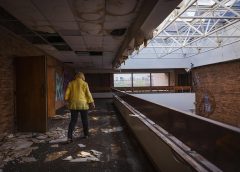
Building a high-tech ‘jungle’ for creative industries
[ad_1]

Copyright © 2022 Albuquerque Journal
The old First Baptist Church sanctuary and office tower at Broadway and Central Downtown may soon become a high-tech development center for next-generation, mixed-reality technologies.
That’s the emerging vision for the University of New Mexico’s next phase of development at Innovate ABQ – the seven-acre site that UNM acquired in 2014 to build a bustling research and development zone for innovation and entrepreneurship in the heart of Albuquerque.
Rainforest Innovations, which manages all of UNM’s technology transfer and economic development initiatives, is working with the co-founder and former CEO of Meow Wolf, Vince Kadlubek, to study the potential for converting the old church into a modern incubator for creative individuals, professionals and entrepreneurs to integrate emerging, 21st century technologies into everything they do.
It would be a central gathering and collaboration space where people come together to create new, innovative products and services that they can test, demonstrate and display through mixed- and virtual-reality platforms. That could include everything from film, music and social media to game-engine development, advanced web technologies and even transformational therapies that combine breakthroughs in robotics and medicine to treat both mental illness and physical disabilities.
The foundational concepts are still evolving for the incubator, which Kadlubek and the UNM team have dubbed “The Jungle” to conjure up the image of a “wildly productive” place where people from all backgrounds come together to create things that didn’t exist before, said Rainforest Innovations president and CEO Lisa Kuuttila.
“It would be a multi-faceted facility for technology development in the creative industries,” Kuuttila told the Journal. “We envision a central gathering place that includes co-working spaces and high-tech installations for demonstrations, presentations and even entertainment.”
The next phase
Kadlubek will present his emerging concept for The Jungle on Wednesday during a five-year anniversary celebration for the Lobo Rainforest Building, which UNM opened in 2017.
The Rainforest building’s inauguration – combined with the launch that same year of Central New Mexico Community College’s FUSEMakerspace next door – marked the first phase of development at Innovate ABQ, which UNM plans to build out over time in cooperation with public and private partners.
After it opened in 2017, the $35 million, six-story Rainforest building became a central hub for startup activity and entrepreneurship Downtown. But further build out of the full, 7-acre Innovate ABQ site has almost completely stalled since then, in good part because of financial difficulties and legal issues faced by a now-defunct nonprofit entity that UNM had set up in 2015 to independently manage the site.
The university retook control of the property in summer 2020, and has since pursued redevelopment of the 71,000-square-foot former church building for the next phase of Innovate ABQ.

That building – which sits smack on the southeast corner of the property – was constructed in stages over 70 years. It includes a massive, two-story chapel with a public entranceway facing Central Avenue, plus a five-story office tower behind it.
A separate, two-story structure that previously served as a church school is also connected to the sanctuary and tower, jutting out westward along Central.
UNM expects to preserve the historic east-side sanctuary and tower, remodeling the structure into a high-tech home for The Jungle.
It’s unclear, however, what will happen with the two-story west wing, which UNM expected to turn into a new bioscience center with wet labs and offices for startup companies.
California-based HatchSpaces LLC – which specializes in building research and development facilities for bioscience companies – signed a lease for the west wing early this summer to build out and manage the new biotechnology lab.
But the company unexpectedly terminated its lease on Aug. 17, throwing the west-wing conversion into doubt, said UNM Real Estate Director Tom Neale.
“HatchSpaces determined that the cost to renovate and convert it into a bioscience lab proved too risky in terms of leasing the space to individual companies,” Neale told the Journal. “But that doesn’t mean that part of the church building isn’t viable for other business endeavors. The old school could become part of The Jungle.
“We’re keeping our options open,” Kuuttila said. “We’d still like to pursue the west wing as a bioscience center, but it could also become part of the digital arts facility we’re planning.”
Think Meow Wolf
UNM pulled Kadlubek into its creative technologies project in March to tap into his knowledge and experience in redesigning existing spaces into modern, high-tech venues that appeal to younger generations as the metaverse – or the emerging concept of comprehensive online immersion for everyday work and life – develops into a future foundation for enhanced human interaction.
Kadlubek helped turn Meow Wolf into an international cultural phenomenon, converting a gutted bowling alley in Santa Fe into a mecca of art and imagination based on human and technological creativity. He’s since co-founded Spatial Activations as a creative consultant agency to help developers incorporate those same imaginative concepts into the design of other physical spaces like the old church building at Innovate ABQ.
For The Jungle, his vision is to “marry” the immersive arts and entertainment economy – think Meow Wolf and the Van Gogh exhibit that recently landed in Albuquerque – with next-generation web technologies like “spatial computing” to create a place where creative-minded individuals from many industries can come together to build new things.
Spatial computing refers to the merger of technology like sensors, superfast data analytics and virtual reality with real-world activities, creating a “mixed reality” for interactive human interaction.
“It all falls under the realm of the metaverse,” Kadlubek told the Journal. “There hasn’t been a dedicated space that I know of to apply and showcase these next-generation web technologies and projects, although a lot of people are working on it.”
That includes everything from arts and entertainment to robotics and advanced web platforms like blockchain architecture that enables secure online transactions. Game development, for example, extends far beyond entertainment markets.
“Game engines are not just for developing games, but for building the future of the metaverse,” Kadlubek said. “It all crosses over, and it’s at the core of many future jobs. It would be a mixed-industry hub for what comes next for New Mexico and elsewhere.”
Ideal venue
Apart from the building’s numerous offices and open areas for individual and collaborative work, the chapel itself offers a spacious, ready-made venue for community events, presentations and even arts-related entertainment, said Kelly Ward, executive director of UNM’s Lobo Development Corp.

“We’ve been working to reimagine what those church spaces should look like, but we’ve always envisioned the sanctuary as a place for large gatherings, presentations and performance,” Ward told the Journal. “… We could do events with up to 1,200 people by extending the venue into the digital world with virtual reality headsets for people elsewhere to participate.”
Remodeling plans would incorporate cutting-edge technology directly into the building’s new design to enable virtual participation and other immersive experiences in the chapel, and to do everything from modeling and simulation to testing and demonstrating new products and services in other spaces.
“It would be purpose-built with the needed technologies embedded in the design,” Ward said.
That could include spatial sensors for location and position tracking, plus audio sensors and projection mapping, all backed by wireless, superfast 5G and 6G networks, Kadlubek said.
“Those things would be incorporated into the building like 21st century plumbing for the metaverse,” he said.
The project and building design is still in the concept stage.
“We’re assessing if it’s viable and trying to refine it all,” Ward said. “It could easily take 12 months to decide on whether we’ll pursue it.”
But the university team is gung-ho on the possibilities.
“I’m jazzed about it as a way to incite thought and action for people to come to the site to be on the forefront of emerging industries,” Ward said. “That includes lab people, university people and everyday folks who want to get involved. We’d open it all up to people’s great ideas.”
[ad_2]
Source link


